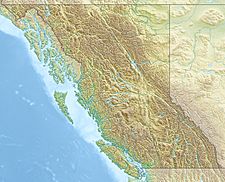Capricorn Mountain facts for kids
Quick facts for kids Capricorn Mountain |
|
|---|---|
| Highest point | |
| Elevation | 2,551 m (8,369 ft) |
| Prominence | 303 m (994 ft) |
| Listing | Mountains of British Columbia |
| Geography | |
| Location | British Columbia, Canada |
| Parent range | Pacific Ranges |
| Geology | |
| Age of rock | Pleistocene |
| Mountain type | Stratovolcano |
| Volcanic arc/belt | Canadian Cascade Arc Garibaldi Volcanic Belt |
| Last eruption | Pleistocene |
| Climbing | |
| First ascent | 1931 N. Carter; A. Dalgleish; T. Fyles; M. Winram |
| Easiest route | Climbing |
Capricorn Mountain is a cool volcanic peak located in southwestern British Columbia, Canada. It's part of a bigger group of mountains called the Mount Meager massif. Unlike some other jagged peaks, Capricorn Mountain has slopes that look a bit gentler. It's shaped like a boomerang, with a main summit in the middle and two smaller peaks at each end.
Contents
About Capricorn Mountain
Capricorn Mountain stands tall at 2,551 meters (about 8,369 feet) above sea level. This makes it one of the higher points in the area. It's also quite noticeable because it rises about 303 meters (994 feet) above the land around it.
Where is it?
This mountain is found in the beautiful province of British Columbia, which is on the west coast of Canada. It's part of a larger mountain range known as the Pacific Ranges. These ranges are famous for their rugged beauty and many peaks.
What Kind of Mountain Is It?
Capricorn Mountain is a type of volcano called a stratovolcano. Imagine a cone-shaped volcano built up over time by layers of hardened lava, ash, and rocks from past eruptions. That's a stratovolcano!
It's part of two important volcanic areas: the Canadian Cascade Arc and the Garibaldi Volcanic Belt. These are chains of volcanoes that stretch across parts of North America. They show where Earth's plates are moving and creating volcanic activity.
When Did It Form?
Capricorn Mountain was formed a long, long time ago during a period called the Pleistocene epoch. This was an ice age period that lasted from about 2.6 million to 11,700 years ago. The last time Capricorn Mountain erupted was also during the Pleistocene. So, it's been a very long time since it was active!
Reaching the Top
The first people to successfully climb Capricorn Mountain were N. Carter, A. Dalgleish, T. Fyles, and M. Winram. They made their way to the summit in 1931. The easiest way to climb it is through general Climbing routes, which means it might involve some hiking and basic mountaineering skills.


